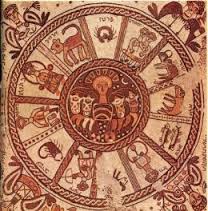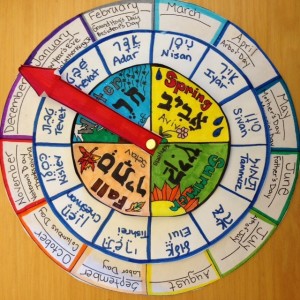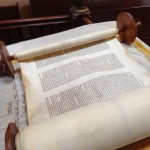#21 Jewish Time – The Lunisolar Calendar
#21 Beliefs and Practices: Jewish Time – The Jewish Lunisolar Calendar
 Shalom! In this session, you will learn about the unique character of Jewish time:
Shalom! In this session, you will learn about the unique character of Jewish time:
- What: What is Jewish time? Months, days, etc.
- How: How does Jewish time influence Jewish practice?
- What: What is Rosh Chodesh? Lunar Calendar? Solar Calendar?
- Fun: Make your own Jewish calendar wheel
#1 WATCH: What are the names of the 12 Jewish Months?
#2 STUDY: A CALENDAR OF NAMES
Here are the names of the Jewish months:
The months of Nisan (March-April), Sivan (May-June), Av (July-August), Tishrei (September-October), and Shevat (January-February) are always thirty days long.
Iyyar (April-May), Tammuz (June-July), Elul (August-September), Tevet (December-January), and Adar (March-April) are always twenty-nine days long. Heshvan (October-November) and Kislev (November-December) are either twenty-nine or thirty days in length. In a leap year, there are two months of Adar.
The names of the Jewish months are Babylonian in origin as the calendar system was finalized during the time of the Babylonian exile in the 6th century BCE.
#3 WATCH: WHAT IS A LUNAR CALENDAR?
#4 STUDY: GREAT CALENDAR FACTS:
- As the earth rotates around the sun and it takes 365 days to complete a full yearly cycle
- As the moon rotates, it takes 354 days to complete a full cycle.
- When there is a new moon, it is called Rosh Chodesh, the “head of the month”, ie, the new month.
- Since a new day begins when the moon emerges in the evening, the new day on the Jewish calendar starts at sundown (on the Western calendar, the new days starts with the sunrise since it is a solar-sun calendar).
- For this reason, Shabbat and all Jewish holidays begin and end at sundown or “moon-up.”
Some important dates in the Jewish calendar:
- 1 Tishre, Jewish New Year, Rosh Hashanah,
- 10 Tishre, Yom Kippur
- 15 Kislev, Hanukkah
- 15 Nissan, Passover
#5 WATCH: Deepen your knowledge about the Jewish Calendar.
“And there was evening, and there was morning, a new day”
This refrain happens six different times in first chapter in the Book of Genesis which is proof that the Jewish people have always followed the Lunar (moon) calendar since the time of the Torah.
#6 Have some fun: make your own calendar wheel
 1. Download and print copies of the calendar circles here
1. Download and print copies of the calendar circles here
2. Cut out circles and one arrow and decorate with your favorite colors. Look at the picture of the wheel on the left of the page. In this version, different colors were used for each secular month.
3. After decorating each of the circles the paper arrow, assemble the pieces together with a brass fastener. Connect each of the circles one on top of the other (secular calendar circle on the bottom, Jewish calendar next, seasons calendar on top of that and then last the arrow).
4. Enjoy and have fun!
# 7 Review and Response Now that you have watched the videos, read the story, and learned about the Jewish Calendar, please respond to these questions. Good luck!
1. Does the Jewish calendar revolve around the moon or the sun?
2. When does a new day start in the Jewish week?
3. What are the Jewish dates of: Rosh Hashanah, Yom Kippur, Passover, and Hanukkah?
4. How many months are in the Jewish year?
5. In what language are the names of the Jewish months?
6. Is there one thing in your life that you would want to have more courage to face?
7. Fun Fact: Did you know that the the word “sin” means “moon” in Akkadian, an ancient near eastern language? Similar to Mt. Sinai. Interesting . . .
Need some help? We’re here for you. At any time, if you have any questions, please contact one of our teachers so we can help you. Also, at the end of the session, remember to review your responses in your Tamid Workbook so you can get credit for this lesson. Behatzlacha (Hebrew for good luck)! You can reach Sarah at (646)360-0689 or connect@tamidnyc.org

